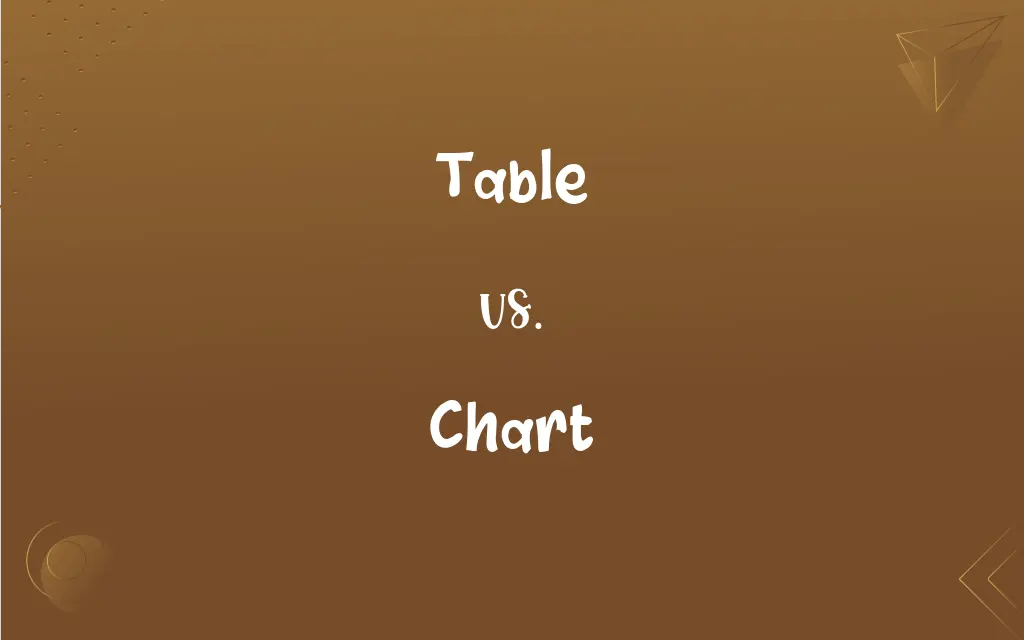Table vs. Chart: What's the Difference?
Edited by Aimie Carlson || By Harlon Moss || Updated on October 17, 2023
A table organizes data into rows and columns, allowing for detailed comparisons. A chart visually represents data, making patterns and trends easier to discern.

Key Differences
A table is a structured arrangement of data that is organized into rows and columns. This systematic format allows for easy reference and is especially effective when the reader needs to compare specific details or when the exact numbers are vital. Each cell within a table holds a piece of data, making it possible to quickly find the desired information by intersecting the appropriate row and column.
Conversely, a chart is a graphical representation of data, designed to showcase patterns, relationships, or trends within that data. Charts can come in various forms, such as bar charts, pie charts, or line graphs. The primary advantage of a chart is that it provides a visual interpretation, allowing viewers to grasp complex data sets at a glance and making it easier to convey a particular message or observation.
While both tables and charts serve the purpose of presenting data, the way they do so differs greatly. A table provides a detailed, text-based breakdown, offering precision and granularity. It is well-suited for exact figures and when comparisons across multiple data points are needed.
Charts, on the other hand, prioritize the visual element. They excel in situations where the overall trend, distribution, or relationship is more important than specific values. Charts can quickly convey an overall narrative about the data, which might be lost in the granularity of a table.
In conclusion, whether one uses a table or a chart largely depends on the nature of the data and the intended audience. While tables offer a detailed breakdown, charts simplify data into a visual format, making complex patterns more digestible.
ADVERTISEMENT
Comparison Chart
Primary Use
Detailed data organization
Visual data representation
Format
Rows and columns
Graphical (bars, lines, pie slices, etc.)
Detail Level
High (exact figures)
General (trends, distributions)
Ease of Interpretation
Requires more scrutiny
Quick visual comprehension
Best For
Comparisons, exact values
Patterns, trends, overall data narratives
ADVERTISEMENT
Table and Chart Definitions
Table
A grid of rows and columns used to display data.
The report included a table of the company's monthly sales.
Chart
A sheet of information in the form of a table or diagram.
The doctor referred to a growth chart to track the child's progress.
Table
A structured format for organizing information systematically.
She prepared a table comparing the features of each product.
Chart
A visual tool used to depict trends, patterns, or relationships in data.
Using a pie chart, she highlighted the market share of each competitor.
Table
A piece of furniture with a flat top supported by legs.
The dining room had a large wooden table.
Chart
A graphical representation of data.
The chart showed a steady increase in sales over the year.
Table
A means of presenting detailed data for reference purposes.
Refer to the table in Appendix A for the full dataset.
Chart
A detailed map, especially a naval or aerial one.
The captain consulted the chart before setting the course.
Table
A flat surface, usually rectangular, upon which objects can be placed.
He set his coffee mug on the table.
Chart
A ranking of popular songs or albums.
Her new song quickly climbed the music charts.
Table
A piece of furniture usually supported by one or more legs and having a flat top surface on which objects can be placed
A dinner table.
A poker table.
Chart
A map showing coastlines, water depths, or other information of use to navigators.
Table
The objects laid out for a meal on this article of furniture.
Chart
An outline map on which specific information, such as scientific data, can be plotted.
FAQs
How does a chart visually represent data?
A chart uses graphical elements, like bars or lines, to depict trends, patterns, or distributions.
What is the primary purpose of a table?
A table organizes detailed data into rows and columns for easy reference.
Can tables and charts be used together?
Yes, often a report may include both tables for detailed data and charts for visual representation.
Can tables show relationships between two variables?
Yes, by cross-referencing rows and columns, relationships can be observed in a table.
When might a bar chart be used?
Bar charts are often used to compare quantities of different categories.
Which is better for showing data trends over time?
A chart, like a line graph, is typically better for showing trends.
Are tables suitable for representing large amounts of data?
While tables can represent large data sets, they might be overwhelming; summarizing data in a chart might be clearer.
What is a common type of chart for showing percentages of a whole?
A pie chart is commonly used for that purpose.
Is a table always rectangular?
While commonly rectangular, tables can also be square or other shapes based on the data.
When might you use a table in daily life?
Shopping lists, schedules, and budgets are everyday examples of tables.
Do all tables need a header row?
While not mandatory, header rows help identify the data in the columns.
Are there different types of charts?
Yes, there are various types like bar, pie, line, scatter plots, and more.
What’s an example of a specialized chart?
A Gantt chart is specialized for project management timelines.
Are there 3D charts?
Yes, some software allows for 3D chart visualization, like 3D pie or bar charts.
Can charts represent negative values?
Yes, many chart types, like bar or line graphs, can depict negative values.
Can a table help in making decisions?
Yes, tables provide detailed data that can inform decision-making.
How can I quickly discern specific data points in a table?
By intersecting the appropriate row and column.
Can charts be interactive?
Yes, many digital charts allow users to interact, zooming in or filtering data.
When is a table more beneficial than a chart?
When precise values and detailed comparisons are essential, tables are often more beneficial.
Why might one choose a chart over a table?
A chart offers a quick visual representation, making it easier to grasp overall patterns or trends.
About Author
Written by
Harlon MossHarlon is a seasoned quality moderator and accomplished content writer for Difference Wiki. An alumnus of the prestigious University of California, he earned his degree in Computer Science. Leveraging his academic background, Harlon brings a meticulous and informed perspective to his work, ensuring content accuracy and excellence.
Edited by
Aimie CarlsonAimie Carlson, holding a master's degree in English literature, is a fervent English language enthusiast. She lends her writing talents to Difference Wiki, a prominent website that specializes in comparisons, offering readers insightful analyses that both captivate and inform.































































